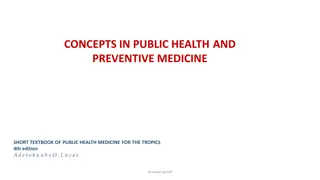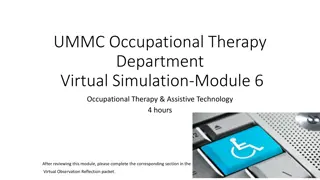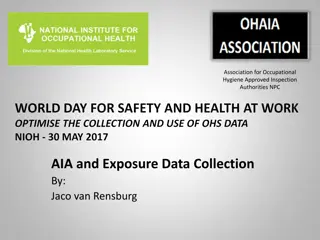Spirometry in Occupational Medicine
Spirometry is a physiological test used in occupational medicine for various purposes like assessing cardiopulmonary fitness for specific jobs, monitoring therapeutic interventions, and evaluating individuals exposed to harmful agents. It helps in diagnosing symptoms, measuring pulmonary function effects, screening high-risk individuals, and assessing preoperative risks. The test is essential in primary prevention for pre-employment screenings and in secondary prevention through medical surveillance programs. Understanding the indications, contraindications, complications, and interpretation of spirometric values is crucial for accurate evaluation and management of respiratory health in occupational settings.
Download Presentation

Please find below an Image/Link to download the presentation.
The content on the website is provided AS IS for your information and personal use only. It may not be sold, licensed, or shared on other websites without obtaining consent from the author.If you encounter any issues during the download, it is possible that the publisher has removed the file from their server.
You are allowed to download the files provided on this website for personal or commercial use, subject to the condition that they are used lawfully. All files are the property of their respective owners.
The content on the website is provided AS IS for your information and personal use only. It may not be sold, licensed, or shared on other websites without obtaining consent from the author.
E N D
Presentation Transcript
King Saud University College of Business Administration Department of Health Administration Masters` Program PA 509-Quality Control in Healthcare Second Semester 1439/ 1440 Mohammed S. Alnaif, Ph D. alnaif@ksu.edu.sa Mohammed Alnaif Ph.D. 3/14/2025 1
Healthcare Quality at the Organization and Microsystem Levels Data Collection Everywhere you turn, everyone wants data. What do they really mean? Where do you get data? Is chart review the gold standard, the best source? Are administrative databases reliable; can they be the gold standard? Mohammed Alnaif Ph.D. 3/14/2025 2
Healthcare Quality at the Organization and Microsystem Levels Data Collection What about health plan claims databases are they accurate? What is the best source for inpatient data that reflects the quality of patient care from both a process and an outcome perspective? When working in the outpatient environment, where and how would you obtain data that reflect the level of quality delivered in physician office practices? Mohammed Alnaif Ph.D. 3/14/2025 3
Data Collection Categories of Data: Case example Quality measurements can be grouped into four categories or domains: 1. Clinical quality (including both process and outcome measures); 2. Financial performance; 3. Patient, physician, and staff satisfaction; and 4. Functional status. Mohammed Alnaif Ph.D. 3/14/2025 4
Data Collection Categories of Data: Case example Quality measurements To report on each of these categories, one may need to collect data from several separate sources. The challenge is to collect as many data elements from as few data sources as possible with the objectives of consistency and continuity in mind. For most large and mature quality improvement projects, teams will want to report their organization s performance in all four domains. Mohammed Alnaif Ph.D. 3/14/2025 5
Data Collection Categories of Data: Case example Spectrum Health s clinical reporting (CR) system illustrates this point. The CR system contains more than 50 disease-specific dashboards that report performance at the system, hospital, and physician levels (see Exhibit 5.1). In Exhibit 5.2, a dashboard for total hip replacement provides examples of clinical quality and financial performance measures. To produce the CR system, Spectrum Health used a variety of data sources, including extracts from its finance and electronic health record (EHR) systems. Mohammed Alnaif Ph.D. 3/14/2025 6
Data Collection Categories of Data: Case example The decision support department processed the data, applying a series of rigorous data cleanup algorithms, adjusting for severity, and adding industry benchmarks. The resulting report contains measures of clinical processes (antibiotic utilization, deep vein thrombosis [DVT] prophylaxis, beta-blocker administration, autologous blood collection, and blood product administration), financial performance (lengths of stay, total patient charges, pharmacy charges, lab charges, X-ray charges, and intravenous therapy charges), and clinical out- comes (DVT, acute myocardial infarction [AMI], and readmission within 31 days). Mohammed Alnaif Ph.D. 3/14/2025 7
Data Collection Categories of Data: Case example From more than 200 indicators available in the database, the total joint quality improvement team selected these measures as the most important for assessing the quality and cost of care delivered. The measures also include some Joint Commission core measures. To obtain patient satisfaction information, the team uses industry- standard patient satisfaction surveys. The outbound call center administers these surveys by telephone within one week of a patient s discharge. The results can be reported by nursing unit or physician, are updated monthly, and can be charted over the past eight quarters. Mohammed Alnaif Ph.D. 3/14/2025 11
Data Collection Categories of Data: Case example To complete the measurement set, the team includes the results of patients functional status (following their treatments). This information can be obtained from patients EHRs (if it has been included in them) or by using survey tools during follow-up visits. Many hospital procedures are performed to improve patients functional status. A patient who undergoes a total knee replacement, for example, should experience less knee pain when he or she walks, have a good range of joint motion, and be able to perform the activities of daily living that most of us take for granted. Mohammed Alnaif Ph.D. 3/14/2025 12
Data Collection Categories of Data: Case example For this report, the team examines patients functional status before and after hospitalization to demonstrate that their treatments were effective. In summary, when designing data collection efforts, quality improvement teams need to maintain a balanced perspective of the process of care by collecting data in all four categories: clinical quality, financial performance, patient satisfaction, and functional status. Teams that fail to maintain this balance may overlook critical information. Mohammed Alnaif Ph.D. 3/14/2025 13
Data Collection Considerations in Data Collection Time and Cost Involved in Data Collection The key is to balance the cost of data collection and the value of the data to your improvement efforts. In other words, are the cost and time spent collecting data worth the effort? Will the data have the power to drive change and improvement? Mohammed Alnaif Ph.D. 3/14/2025 14
Data Collection Considerations in Data Collection Time and Cost Involved in Data Collection Generally, medical record review and prospective data collection are considered the most time-intensive and expensive ways to collect information. Many reserve these methods for highly specialized improvement projects or use them to answer questions that have surfaced following review of administrative data sets. Use of administrative data is often considered cost-effective, especially because the credibility of administrative databases has improved and continues to improve through the efforts of coding and billing regulations, initiatives, and rule-based software development. Mohammed Alnaif Ph.D. 3/14/2025 15
Data Collection Considerations in Data Collection Time and Cost Involved in Data Collection The following situation illustrates how the cost- effectiveness of an administrative system can be combined with the detailed information available in a medical record review. A data analyst using a clinical decision support system (administrative database) discovered a higher-than- expected incidence of renal failure (a serious complication) following coronary artery bypass surgery. The rate was well above 10 percent for the most recent 12 months (more than 800 patients were included in the data set) and had slowly increased over the past six quarters. Mohammed Alnaif Ph.D. 3/14/2025 16
Data Collection Considerations in Data Collection Time and Cost Involved in Data Collection However, the clinical decision support system did not contain enough detail to explain why such a large number of patients were experiencing this complication whether this complication resulted from the coronary artery bypass graft procedure or was a chronic condition present on admission. To find the answer, the data analyst used chart review to: 1. Verify that the rate of renal failure as reported in the administrative data system was correct, 2. Isolate cases of postoperative incidence, 3. Identify the root cause(s) of the renal failure, and 4. Answer additional questions about the patient population that were of interest to the physicians involved in the patients care. Mohammed Alnaif Ph.D. 3/14/2025 17
Data Collection Considerations in Data Collection Time and Cost Involved in Data Collection In this example, the analyst used the administrative system to identify unwanted complications in a large patient population (a screening or surveillance function) and reserved chart review for a much smaller focused study (80 charts) to validate the incidence and determine why the patients were experiencing the complication. This excellent example shows effective use of two common data sources and demonstrates how the analyst is able to capitalize on the strengths of both while using each most efficiently. Mohammed Alnaif Ph.D. 3/14/2025 18
Data Collection Considerations in Data Collection Collecting the Critical Few Rather than Collecting for a Rainy Day Many quality improvement efforts collect every possible data element in case it might be needed. Ironically, justification for this approach is often based on saving time the chart has already been pulled, so one might as well be thorough. This syndrome of stockpiling just in case versus fulfilling requirements just in time has been studied in supply chain management and proven to be ineffective and inefficient. Mohammed Alnaif Ph.D. 3/14/2025 19
Data Collection Considerations in Data Collection Collecting the Critical Few Rather than Collecting for a Rainy Day This approach provides little value to the data collection effort and is one of the biggest mistakes quality improvement teams make. Rather than provide a rich source of information, this approach unnecessarily drives up the cost of data collection, slows the data collection process, creates data management issues, and overwhelms the quality improvement team with too much information. Mohammed Alnaif Ph.D. 3/14/2025 20
Data Collection Considerations in Data Collection Collecting the Critical Few Rather than Collecting for a Rainy Day For all quality improvement projects, it is critical to collect only the data required to identify and correct quality issues. As a rule in ongoing data collection efforts, quality improvement teams should be able to link every data element collected to a report, thereby ensuring that teams do not collect data that will not be used. In the reporting project discussed earlier, the hospital team was limited to selecting no more than 15 measures for each clinical condition. Mohammed Alnaif Ph.D. 3/14/2025 21
Data Collection Considerations in Data Collection Collecting the Critical Few Rather than Collecting for a Rainy Day It also selected indicators that: 1. Have been shown by evidence-based literature to have the greatest effect on patient outcomes (e.g., in congestive heart failure, the use of angiotensin converting enzyme [ACE] inhibitors and beta blockers and evaluation of left ventricular ejection fraction); 2. Reflect areas in which significant improvements are needed; 3. Will be reported in the public domain (Joint Commission core measures); and 4. Together provide a balanced view of the clinical process of care, financial performance, and patient outcomes. Mohammed Alnaif Ph.D. 3/14/2025 22
Data Collection Considerations in Data Collection Inpatient versus Outpatient Data The distinction between inpatient and outpatient data is an important consideration in planning the data collection process because the data sources and approaches to data collection can be different. The case of a team working on a diabetes disease management project illustrates this point. First, disease management projects tend to focus on the entire continuum of care, so the team needs data from both inpatient and outpatient settings. Mohammed Alnaif Ph.D. 3/14/2025 23
Data Collection Considerations in Data Collection Inpatient versus Outpatient Data Second, the team needs to identify whether patients receive the majority of care in one setting or the other and decide whether data collection priorities should be established with this setting in mind. For diabetes, the outpatient setting has the most influence on patient outcomes, so collection of outpatient data is a priority. Third, the team must select the measures that reflect the aspects of care that have the most influence on patient outcomes. Mohammed Alnaif Ph.D. 3/14/2025 24
Data Collection Considerations in Data Collection Inpatient versus Outpatient Data Remembering to collect the critical few (as discussed in the previous section), the team would consult the American Diabetes Association (ADA) guidelines for expert direction. Fourth, the team must recognize that the sources of outpatient data are much different from the sources of inpatient data, and outpatient data tend to be more fragmented and harder to obtain. However, with the advent of outpatient EHRs and patient registries, the ease of collecting outpatient data is improving. Mohammed Alnaif Ph.D. 3/14/2025 25
Data Collection Sources of Data Some sources are simple to access, while accessing others are complex; some data sources are inexpensive to use, while others are expensive. In the average hospital or health system, data sources include medical records, prospective data collection, surveys of various types, telephone interviews, focus groups, administrative databases, health plan claims databases, cost accounting systems, patient registries, stand-alone clinical databases, EHRs, and lab and pharmacy databases. Mohammed Alnaif Ph.D. 3/14/2025 26
Data Collection Sources of Data The following objectives are essential to a successful quality improvement project and data collection initiative: Identify the purpose of the data measurement activity (i.e., for monitoring at regular intervals, investigation over a limited period, or a onetime study). Identify data sources that are most appropriate for the activity. Identify the most important measures to collect (the critical few). Design a common-sense strategy that will ensure collection of complete, accurate, and timely information. Mohammed Alnaif Ph.D. 3/14/2025 27
Data Collection Sources of Data Medical Record Review (Retrospective) Retrospective data collection involves identification and selection of a patient s medical record or group of records after the patient has been discharged from the hospital or clinic. Records generally cannot be reviewed until all medical and financial coding is complete because codes are used as a starting point for identifying the study cohort. Mohammed Alnaif Ph.D. 3/14/2025 28
Data Collection Sources of Data Medical Record Review (Retrospective) For several reasons, many quality improvement projects depend on medical record review for data collection. First, many proponents of medical record review believe it to be the most accurate method of data collection. They believe that because administrative databases have been designed for financial and administrative purposes rather than for quality improvement, the databases contain inadequate detail, many errors, and dirty data that is, data that make no sense or appear to have come from other sources. Mohammed Alnaif Ph.D. 3/14/2025 29
Data Collection Sources of Data Medical Record Review (Retrospective) Second, some improvement projects rely on medical record review because many of the data elements are not available from administrative data- bases. For example, most administrative databases do not contain measures that require a time stamp, such as administration of antibiotics within one hour before surgical incision. Mohammed Alnaif Ph.D. 3/14/2025 30
Data Collection Sources of Data Medical Record Review (Retrospective) Third, several national quality improvement database projects including the Healthcare Effectiveness Data and Information Set (HEDIS), Joint Commission core measures, Leapfrog Hospital Survey, and National Quality Forum s (NQF) National Voluntary Consensus Standards for Hospital Care depend on retrospective medical record review for collecting a significant portion of the data elements required to be reported. Mohammed Alnaif Ph.D. 3/14/2025 31
Data Collection Sources of Data Medical Record Review (Retrospective) Fourth, focused medical record review is the primary tool for answering the why of given situations (e.g., why patients were experiencing a particular complication, why a certain intervention negatively affected patient outcomes). Medical record review continues to be a key component of many data collection projects, but it needs to be used judiciously because of the time and cost involved unless if have EMR s. Mohammed Alnaif Ph.D. 3/14/2025 32
Data Collection Sources of Data Medical Record Review (Retrospective) The approach to medical record review involves a series of well- conceived steps, beginning with the development of a data collection tool and ending with the compilation of collected data elements into a registry or electronic database for review and analysis. Mohammed Alnaif Ph.D. 3/14/2025 33
Data Collection Sources of Data Prospective Data Collection, Data Collection Forms, and Scanners Prospective data collection also relies on medical record review, but it is completed during a patient s hospitalization or visit rather than retrospectively. Nursing staff, dedicated research assistants, or full- time data analysts commonly collect the data. The downside to asking nursing staff to collect data is the effort involved; it is a time-consuming task that can distract nurses from their direct patient care responsibilities. Mohammed Alnaif Ph.D. 3/14/2025 34
Data Collection Sources of Data Prospective Data Collection, Data Collection Forms, and Scanners A better approach would be to hire research assistants or full-time data analysts who can collect the data and be responsible for data entry and analysis. Because this job is their sole responsibility, the accuracy of data collection is greater. If they also are responsible for presenting their analyses to various quality committees, they are likely to review the data more rigorously. Mohammed Alnaif Ph.D. 3/14/2025 35
Data Collection Sources of Data Prospective Data Collection, Data Collection Forms, and Scanners Obviously, this method of data collection is expensive, but if staff can minimize the time required for data entry, it can focus on accuracy and analysis/reporting. Converting the data collection forms into a format that can be scanned is one way to save time. Alternatively, data collection forms can be developed for tablet technology that automatically downloads the collected data to project databases. Mohammed Alnaif Ph.D. 3/14/2025 36
Data Collection Sources of Data Prospective Data Collection, Data Collection Forms, and Scanners The most efficient data collection tools follow the actual flow of patient care and medical record documentation, whether the data are collected retrospectively or prospectively. There are numerous advantages to prospective data collection. First, detailed information not routinely available from administrative databases can be gathered. Physiologic parameters can be captured, such as the range of blood pressures for a patient on vasoactive infusions or 24- hour intake and output for patients with heart failure. As discussed earlier, data requiring a time stamp also can be captured. Mohammed Alnaif Ph.D. 3/14/2025 37
Data Collection Sources of Data Prospective Data Collection, Data Collection Forms, and Scanners Timely administration of certain therapies (e.g., administration of antibiotics within one hour before surgical incision or within eight hours of hospital arrival for patients with pneumonia) has shown to improve patient outcomes. The timing of clot buster administration to certain stroke patients can mean the difference between full recovery and no recovery, and the window of opportunity for these patients is small; they usually must receive thrombolytic therapy within three hours of symptom onset. For patients with AMI, the administration of aspirin and beta blockers within the first 24 hours is critical to survival. Mohammed Alnaif Ph.D. 3/14/2025 38
Data Collection Sources of Data Prospective Data Collection, Data Collection Forms, and Scanners Through prospective chart review, the data collection staff can spot patient trends as they develop rather than receive the information after patients have been discharged. For instance, they may detect an increasing incidence of ventilator-associated pneumonia sooner, or they may spot an increase in the rate of aspiration in stroke patients as it occurs. Unfortunately, the downside to this data collection approach is cost. Prospective data collection is costly and time consuming and often requires healthcare organizations to hire several full- time data analysts. Mohammed Alnaif Ph.D. 3/14/2025 39
Data Collection Sources of Data Administrative Databases Administrative databases are a common source of data for quality improvement projects. Administrative data are information collected, processed, and stored in automated information systems. These data include enrollment or eligibility information, claims information, and information on managed care encounters. They may relate to hospital and other facility services, professional services, prescription drug services, or laboratory services. Mohammed Alnaif Ph.D. 3/14/2025 40
Data Collection Sources of Data Administrative Databases Examples of administrative data sources are hospital and physician office billing systems; health plan claims databases, health information management or medical record systems, and registration systems (admission/ discharge/transfer). Ideally, hospitals also maintain a cost accounting system that integrates the previously mentioned systems into one database and provides the important elements of patient cost. Although each of these sources has unique characteristics, for the purposes of this discussion they will be considered collectively as administrative databases (with the exception of health plan claims databases, which are covered later in this chapter). Mohammed Alnaif Ph.D. 3/14/2025 41
Data Collection Sources of Data Administrative Databases Administrative databases are an excellent source of data for reporting on clinical quality, financial performance, and certain patient outcomes. They are the backbone of many quality improvement programs, including the CR system described at the beginning of this chapter. Mohammed Alnaif Ph.D. 3/14/2025 42
Data Collection Sources of Data Advantages of Administrative Databases Their use is less expensive than the use of alternative methods, such as chart review or prospective data collection. They incorporate transaction systems already used in a healthcare organization s daily business operations (frequently referred to as legacy systems). Most of the code sets embedded in administrative databases are standardized, simplifying internal comparison between multifacility organizations and external benchmarking with purchased or government data sets. Mohammed Alnaif Ph.D. 3/14/2025 43
Data Collection Sources of Data Advantages of Administrative Databases Most administrative databases are maintained by individuals who are skilled at sophisticated database queries. Expert database administrators in information technology departments provide database architecture and support. The volume of available indicators is 100 times greater than that available through other data collection techniques. Mohammed Alnaif Ph.D. 3/14/2025 44
Data Collection Sources of Data Advantages of Administrative Databases Data reporting tools are available as part of the purchased system or through third-party add-ons or services. Many administrative databases especially well-managed financial and cost accounting systems are subject to regular reconciliation, audit, and data cleanup procedures that enhance the integrity of their data. Mohammed Alnaif Ph.D. 3/14/2025 45
Data Collection Sources of Data Advantages of Administrative Databases Because of these advantages, many healthcare organizations make extensive use of administrative data systems as the primary source of data for quality improvement projects. Some argue that administrative data are less reliable than data gathered by chart review. Mohammed Alnaif Ph.D. 3/14/2025 46
Data Collection Sources of Data Advantages of Administrative Databases However, when administrative data are properly cleaned and validated, the indicator definitions are clear and concise, and the limitations of the data are understood, administrative data can be just as reliable as data from chart review. These characteristics form a primary basis for the commercial outcome reporting systems available today. Mohammed Alnaif Ph.D. 3/14/2025 47
Data Collection Sources of Data Advantages of Administrative Databases For example, the most common measures from the system described earlier were validated using four approaches: 1. Chart review using an appropriate sampling methodology, 2. Chart review performed for the core measures, 3. Comparison to similar measures in stand-alone databases that rely on chart abstraction or prospective data collection strategies (e.g., National Registry of Myocardial Infarction), and Mohammed Alnaif Ph.D. 3/14/2025 48
Data Collection Sources of Data Advantages of Administrative Databases For example, the most common measures from the system described earlier were validated using four approaches: 4. Face validation performed by physicians with expertise in the clinical condition being studied. Results proved the administrative data sources to be just as reliable. In fact, if systems are not in place to ensure interrater reliability, such as third-party audits, chart review data can be very inaccurate. Mohammed Alnaif Ph.D. 3/14/2025 49
Data Collection Sources of Data Patient Surveys: Satisfaction and Functional Status Patient satisfaction surveys have long been a favorite tool of quality improvement professionals, especially teams interested in the perceptions of patients, either in terms of the quality of care or the quality of service provided. However, underestimation of the scientific complexity underlying survey research often leads to undesirable results. Mohammed Alnaif Ph.D. 3/14/2025 50























